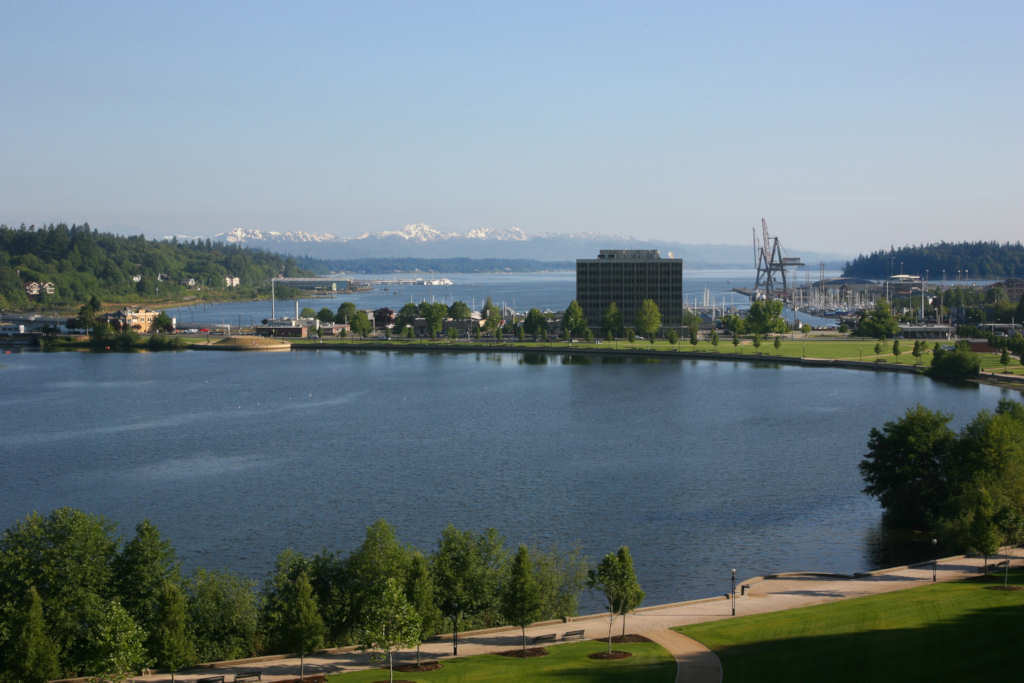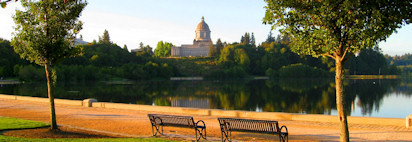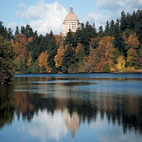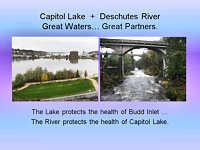Capitol Lake: Protector of Water Qualty in Budd Inlet
Prepared by David H. Milne - March, 2014
Executive Summary
This report was prompted by claims that Capitol Lake has a negative impact on Budd Inlet's water quality and that a reconstructed estuary at the head of the Inlet would be environmentally preferable. My findings contradict such claims.
#1 - I find that the Lake does not have negative effects on Budd Inlet
and that the Lake improves the water quality of the Inlet.
The evidence I analyzed is in a Dept. of Ecology document, the "TMDL Tech Report (2012)" listed in the References. DOE compiled this evidence by using a computer simulation to compare two sets of scenarios, one with a Lake and one with a reconstructed estuary at the head of the Inlet. My analysis is divided into 9 sections. The conclusion of each section (except the Introduction) is as follows:
- 2) The computer calculations presented are only tangentially relevant to a Lake/Estuary comparison and are presented in formats that are very prone to misinterpretation.
- 3) All violations of water quality standards reported by the computer are mathematically microscopic and ecologically inconsequential.
- 4) The TMDL computer simulation data show no water quality problems occurring anywhere at any time throughout Budd Inlet.
- 5) Data that probably show a beneficial effect of Capitol Lake on all of Budd Inlet have been mistakenly presented as showing a negative effect.
- 6) Water exiting Capitol Lake does not go into areas that experience water quality standards violations (East Bay, eg); it flows straight toward the mouth of the Inlet.
- 7) Capitol Lake prevents some 27 metric tons of nitrate nitrogen from entering Budd Inlet every summer - a huge beneficial impact equivalent to the action of two LOTT plants.
- 8) There are many likely sources of East Bay's water quality standards violations in and near that Bay. The Lake is not one of them.
- 9) It seems likely that the "baseline" for simulations of the Lake's effects was wrongly calculated. If so, "Lake Scenario" simulation outcomes are not to be trusted.
I conclude that Capitol Lake is the Deschutes River Watershed's biggest and best asset for preventing and reducing water quality degradation in Budd Inlet.
Detailed Report & Additional Information - PDF Versions
Capitol Lake: Protector of Water Qualty in Budd Inlet (PDF 39 page)
Executive Summary Only (PDF 1 pg)
Peer Reviews of the complete report "Capitol Lake: Protector of Water Qualty in Budd Inlet"
1. Statement by Dr. Gerardo Chin-Leo, Ph.D.
“I think that the study was a thorough analysis of the TDML report. I did not find any factual mistakes, flaws in the logic used in the analysis or misconceptions on estuarine circulation and the process of eutrophication. The study did a good job of pointing out limitations of the model and of presenting alternative explanations for the model results.”
2. Statement by Dr. Erik Thuesen, Ph.D.
“I read the report and I agree that the low DO changes reported by the model are not ecologically significant or even trustworthy.”
3. Statement by Oscar Soule, PhD [Ecology]
“I have read David Milne’s March 17, 2014 report, Capitol Lake: Protector of Water Quality in Budd Inlet, and find it persuasive. I did not find errors of content or omission. I agree with his analyses and recommendations. I hope those collecting information to make decisions of the future of Capitol Lake will heed Dave’s ideas.”
4. Peer Review by Kaye V Ladd, PhD Brandeis University
If anything, Dr. Milne is too kind to the authors of the TMDL report and quite correct in his analysis in his report Capitol Lake: Protector of Water Quality in Budd Inlet. There are 4 attributes that any reader needs to understand in analyzing the argument about the disposition of “Capitol Lake”.
1. “Capitol Lake” is not a lake but the mouth of the Deschutes River as it enters Budd Inlet. The 5th Avenue Dam just mitigates the tidal flow of water from Puget Sound and the flow of water from the Deschutes into Budd Inlet. The situation is much like the flow of water from the Charles River in Massachusetts into Boston Harbor. The Charles River is dammed at Route 28 creating an enormous lake-like system that extends in Cambridge past MIT and Harvard. This area of the Charles is a premier inner-city recreational area which extends past Cambridge through Watertown and Waltham with more river-like characteristics. No one calls the lake-like area “Charles Lake” or “Boston Lake”. It is known as “The Charles River”.
2. Water quality in terms of dissolved oxygen (DO) is always relative to % saturation, not to some arbitrary standard. This is because 100% saturation DO is related to temperature, salinity, and atmospheric pressure. There are tables which give DO under various conditions of temperature and salinity at 1 atmosphere pressure. Nature can have conditions of very low DO. For example, mud flats are usually anaerobic and tide water moving over warm mud flats can have DO’s close to 0 mg/L. In contrast, turbulent water can be supersaturated. For example, the water at the base of falls is supersaturated as are “white caps” in surface waters.
3. Models are judged by their fit to real measurement, not the other way around; i.e. if the model corresponds to measurements then the model is OK, if it does not, then the model is wrong and not useful for predicting anything.
4. An estuary is productive because it brings together the inorganic phosphates in marine water with inorganic nitrogen (nitrates and nitrites) in river water. This combination allows plankton to flourish. Plankton do respire and do not produce oxygen in the dark so growth can result in a natural depletion of oxygen. Bottom feeders have adapted to this and fish do avoid areas of low oxygen.
Dr. Milne’s analysis includes all the above and demonstrates that using the TMDL report to predict outcomes for different scenarios for “Capitol Lake” is inappropriate. Furthermore the current configuration with the 5th Ave. dam is actually helping improve the water quality in Budd Inlet. I have read through his report and found it accurate and informative.
My one objection is with his statement on page 1, that the model used could be powerful and accurate, but was programmed incorrectly. Given Figure 5, I doubt the model could predict anything. There are about 37 measured values in Figure 5 corresponding to points on the model. Of the 37, 15 measured values are more than 2 mg/L different than the values in the model. About 5 values are between 0.5 mg/L and 1 mg/L different. Thus, there is little to no correspondence for over half the comparisons of the measured values and the model. This means a coin toss would do just as good at predicting. If I were doing the analysis, I would have quit at this point and said GIGO (Garbage In Garbage Out). Instead, Dr. Milne carefully demonstrated the many ways in which the report was incorrect.
Detailed Report & Additional Information - PDF Versions
Capitol Lake: Protector of Water Qualty in Budd Inlet (PDF 39 page)
Executive Summary Only (PDF 1 pg)
Capitol Lake: Protector of Water Qualty in Budd Inlet
by: David H. MilneA review of the Wa. State Dept. of Ecology document "TMDL Tech Report (2012)". The conclusion of this review is that Capitol Lake is the Deschutes River Watershed's biggest and best asset for preventing and reducing water quality degradation in Budd Inlet.



